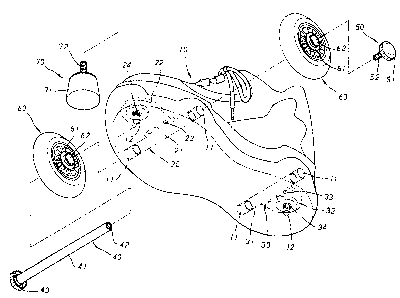Some of the information on this Web page has been provided by external sources. The Government of Canada is not responsible for the accuracy, reliability or currency of the information supplied by external sources. Users wishing to rely upon this information should consult directly with the source of the information. Content provided by external sources is not subject to official languages, privacy and accessibility requirements.
Any discrepancies in the text and image of the Claims and Abstract are due to differing posting times. Text of the Claims and Abstract are posted:
| (12) Patent Application: | (11) CA 2357352 |
|---|---|
| (54) English Title: | BI-FUNCTIONAL ROLLER SKATE |
| (54) French Title: | PATIN A ROULETTES BIFONCTIONNELLE |
| Status: | Deemed Abandoned and Beyond the Period of Reinstatement - Pending Response to Notice of Disregarded Communication |
| (51) International Patent Classification (IPC): |
|
|---|---|
| (72) Inventors : |
|
| (73) Owners : |
|
| (71) Applicants : |
|
| (74) Agent: | SMART & BIGGAR LP |
| (74) Associate agent: | |
| (45) Issued: | |
| (22) Filed Date: | 2001-09-17 |
| (41) Open to Public Inspection: | 2003-03-17 |
| Examination requested: | 2001-09-17 |
| Availability of licence: | N/A |
| Dedicated to the Public: | N/A |
| (25) Language of filing: | English |
| Patent Cooperation Treaty (PCT): | No |
|---|
| (30) Application Priority Data: | None |
|---|
A simply structured bi-functional roller skate has a pair of shoe embodiments.
Each shoe embodiment is provided with a front securing seat which is a tubular
device
with a forwardly extended board, a rear securing seat which is a tubular
device with a
backwardly extended board. Both the front and rear securing seats are embedded
at the
front end and the rear end of each shoe embodiment respectively. Each tubular
device of
the front and rear securing seats is in alignment with an engagement hole so
as to permit
a first and a second wheel axle each having a proper length to be led
therethrough at the
front and rear end of a shoe embodiment. Each wheel axle has a knob-ended
locking
screw at one end and an internally threaded section at the other end so as to
permit the
knob ended locking screw to be secured to the end of each wheel axle after
roller wheels
are mounted to the wheel axles respectively. The brake block has a threaded
rod so as to
make the brake block engaged with an internally threaded holes defined at the
front and
rear securing seats respectively.
Note: Claims are shown in the official language in which they were submitted.
Note: Descriptions are shown in the official language in which they were submitted.

2024-08-01:As part of the Next Generation Patents (NGP) transition, the Canadian Patents Database (CPD) now contains a more detailed Event History, which replicates the Event Log of our new back-office solution.
Please note that "Inactive:" events refers to events no longer in use in our new back-office solution.
For a clearer understanding of the status of the application/patent presented on this page, the site Disclaimer , as well as the definitions for Patent , Event History , Maintenance Fee and Payment History should be consulted.
| Description | Date |
|---|---|
| Inactive: Office letter | 2007-02-27 |
| Inactive: IPC from MCD | 2006-03-12 |
| Inactive: IPC from MCD | 2006-03-12 |
| Inactive: IPC from MCD | 2006-03-12 |
| Time Limit for Reversal Expired | 2005-09-19 |
| Application Not Reinstated by Deadline | 2005-09-19 |
| Inactive: Abandoned - No reply to s.30(2) Rules requisition | 2004-12-03 |
| Deemed Abandoned - Failure to Respond to Maintenance Fee Notice | 2004-09-17 |
| Inactive: S.30(2) Rules - Examiner requisition | 2004-06-03 |
| Application Published (Open to Public Inspection) | 2003-03-17 |
| Inactive: Cover page published | 2003-03-16 |
| Letter Sent | 2002-01-14 |
| Inactive: Correspondence - Transfer | 2002-01-10 |
| Inactive: Correspondence - Formalities | 2001-11-16 |
| Inactive: Single transfer | 2001-11-16 |
| Inactive: First IPC assigned | 2001-11-16 |
| Inactive: Courtesy letter - Evidence | 2001-10-02 |
| Inactive: Filing certificate - RFE (English) | 2001-09-26 |
| Filing Requirements Determined Compliant | 2001-09-26 |
| Application Received - Regular National | 2001-09-26 |
| Request for Examination Requirements Determined Compliant | 2001-09-17 |
| All Requirements for Examination Determined Compliant | 2001-09-17 |
| Abandonment Date | Reason | Reinstatement Date |
|---|---|---|
| 2004-09-17 |
The last payment was received on 2003-06-30
Note : If the full payment has not been received on or before the date indicated, a further fee may be required which may be one of the following
Please refer to the CIPO Patent Fees web page to see all current fee amounts.
| Fee Type | Anniversary Year | Due Date | Paid Date |
|---|---|---|---|
| Request for examination - standard | 2001-09-17 | ||
| Application fee - standard | 2001-09-17 | ||
| Registration of a document | 2001-11-16 | ||
| MF (application, 2nd anniv.) - standard | 02 | 2003-09-17 | 2003-06-30 |
Note: Records showing the ownership history in alphabetical order.
| Current Owners on Record |
|---|
| OCEAN WELL FOOTWEAR CO., LTD. |
| JONG-MING LEE |
| Past Owners on Record |
|---|
| HUNG-LUNG HUANG |